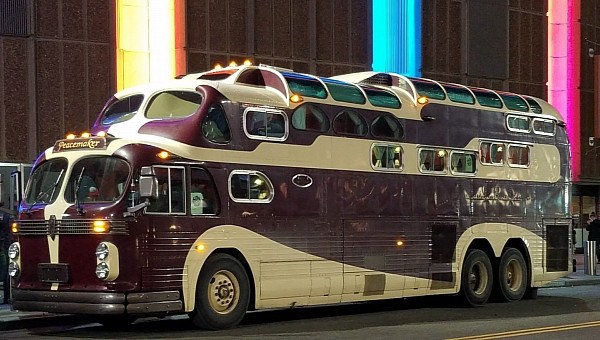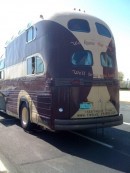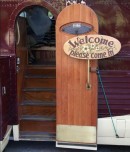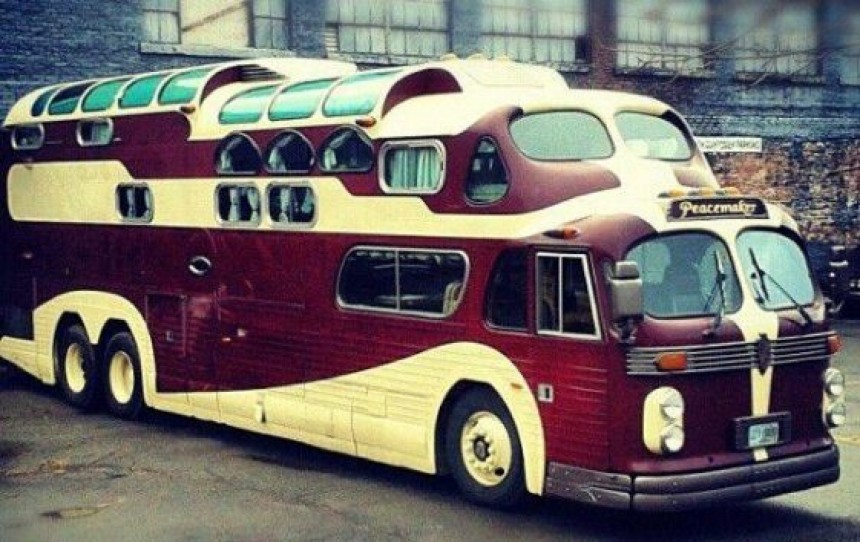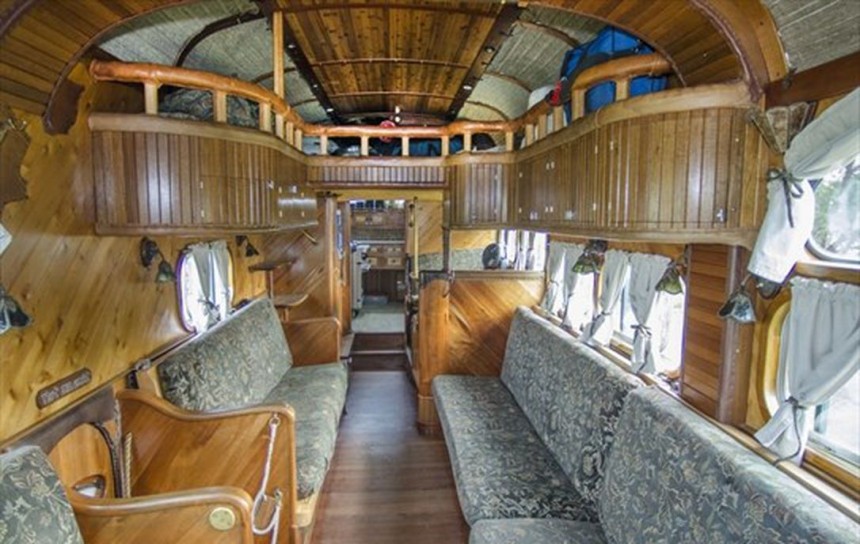A vehicle’s merits or worth should not be dependent on whatever use it’s being put to, or the temperament of the owner. Unless, of course, that vehicle is the Peacemaker.
The Peacemaker is not Bullet Farmer’s ride in Mad Max: Fury Road, despite the fact that both vehicles share the same name. Unlike with that one, this Peacemaker is not named ironically, since it’s envisioned as a vehicle that helps the owners spread and maintain the peace. That’s the less sinister use it’s being put to.
The Peacemaker is known all over the United Statesff and is even considered a staple in American culture. The name actually refers to two vehicles of a similar build (the Peacemaker and the Peacemaker II), and it is also being used for a very beautiful, classically-built barquentine (schooner barque) – yours for $1.25 million, if you’re in the market. All three are owned by the Twelve Tribes, a religious cult slash communal group now operating on an international level, which has been accused of everything from child labor to racism, and about which countless horror stories populate the world wide web. This Daily Beast story sheds some light into life inside the cult.
On the face of it, the Twelve Tribes are a group of hippies who live together in communes all over the world. The religious movement, which combines elements of Hebrew Roots, Christian fundamentalism and Messianic Judanism, started out in Chattanooga, Tennessee, in 1972. Elbert “Gene” Spriggs and his wife became disillusioned with modern religious practices and, after some “shopping around,” decided to start their own church. The Twelve Tribes also own the Yellow Deli and many bakeries across the U.S., for which reason the Peacemaker bus is often associated with “the Yellow Deli people.”
In reality, the Peacemaker is a vehicle to spread the gospel and rein in new members. Urban legend has it that the hippies onboard, Tribes people, prey on the homeless, the addicts, and people struggling with mental issues, to whom they offer a home on the bus, which will then transport them to their new forever home, inside a Tribes commune.
Speaking objectively, the Peacemaker is a beautiful custom vehicle, one that blends the cozy interior of a yacht with the homeliness of an actual home, can accommodate some 20 passengers, sleep about half a dozen on the second level, and always abounds in finger sandwiches, delicious cookies and herbal teas. Perhaps just as impressive is that the Tribes people will often park it in a visible area, and everyone interested in it is welcome onboard. That said, the cult scare of the ‘90s turned the Peacemaker into quite the boogeyman precisely for this very reason.
The first bus conversion hit the road in 1987 and is still around today. The Twelve Tribes would use it to follow acts like The Grateful Dead and Bob Dylan on tour, offering medical assistance to concertgoers struck with the expected ailments at such events: drunkenness, getting lost, and the likes. It was built with a 1961 GMC motor coach and parts from a 1950 Aerocoach, and was instantly noticeable for the “Welcome! Please Come In!” sign always hanging on the door.
In fact, it was an April 3, 1989 Grateful Dead show in Pittsburgh, Pennsylvania that got it its name, when members of the public and the riot police were getting into a heated exchange. According to the Twelve Tribes, the chief of police handed a megaphone to someone on the bus, asking for an intervention, and that person encouraged members of the Tribes to sing and dance, which led to an en-masse dance-along by the previously-riotous crowd, joined by the police officers. The chief of police happily remarked that, “Truly, you are peacemakers!,” and the name stuck with the Tribes people.
Peacemaker II came about in 2005 and was built from a 1955 GMC Scenicruiser and a 1949 General American Aerocoach in an extended and very challenging 2.5-year project. The Scenicruiser was cut in half horizontally and used as the running part, while the Aerocoach was used for its “shapely architectural pieces no longer found,” like the rounded corners and split windows. The result is 42.6-foot (13-meter) long conversion that sits 13.6-feet (4.1-meters) high and is powered by a series 60 engine mated to an automatic transmission, both sourced from other vehicles.
Both buses have walls lined with aromatic cedar and use specialty woods for the furniture, like ash, cherry, black walnut, mahogany and curly apple. Upholstered benches and leather-wrapped seats combine with more rustic elements like handmade stained glass copper lamps or stained glass windows to create a homely, welcoming atmosphere. Which is exactly what a cult would want, if you think about it.
A wonderful, totally hippie but practical bus conversion, the Peacemaker remains the kind of build that’s best admired from afar.
The Peacemaker is known all over the United Statesff and is even considered a staple in American culture. The name actually refers to two vehicles of a similar build (the Peacemaker and the Peacemaker II), and it is also being used for a very beautiful, classically-built barquentine (schooner barque) – yours for $1.25 million, if you’re in the market. All three are owned by the Twelve Tribes, a religious cult slash communal group now operating on an international level, which has been accused of everything from child labor to racism, and about which countless horror stories populate the world wide web. This Daily Beast story sheds some light into life inside the cult.
On the face of it, the Twelve Tribes are a group of hippies who live together in communes all over the world. The religious movement, which combines elements of Hebrew Roots, Christian fundamentalism and Messianic Judanism, started out in Chattanooga, Tennessee, in 1972. Elbert “Gene” Spriggs and his wife became disillusioned with modern religious practices and, after some “shopping around,” decided to start their own church. The Twelve Tribes also own the Yellow Deli and many bakeries across the U.S., for which reason the Peacemaker bus is often associated with “the Yellow Deli people.”
Speaking objectively, the Peacemaker is a beautiful custom vehicle, one that blends the cozy interior of a yacht with the homeliness of an actual home, can accommodate some 20 passengers, sleep about half a dozen on the second level, and always abounds in finger sandwiches, delicious cookies and herbal teas. Perhaps just as impressive is that the Tribes people will often park it in a visible area, and everyone interested in it is welcome onboard. That said, the cult scare of the ‘90s turned the Peacemaker into quite the boogeyman precisely for this very reason.
The first bus conversion hit the road in 1987 and is still around today. The Twelve Tribes would use it to follow acts like The Grateful Dead and Bob Dylan on tour, offering medical assistance to concertgoers struck with the expected ailments at such events: drunkenness, getting lost, and the likes. It was built with a 1961 GMC motor coach and parts from a 1950 Aerocoach, and was instantly noticeable for the “Welcome! Please Come In!” sign always hanging on the door.
In fact, it was an April 3, 1989 Grateful Dead show in Pittsburgh, Pennsylvania that got it its name, when members of the public and the riot police were getting into a heated exchange. According to the Twelve Tribes, the chief of police handed a megaphone to someone on the bus, asking for an intervention, and that person encouraged members of the Tribes to sing and dance, which led to an en-masse dance-along by the previously-riotous crowd, joined by the police officers. The chief of police happily remarked that, “Truly, you are peacemakers!,” and the name stuck with the Tribes people.
Both buses have walls lined with aromatic cedar and use specialty woods for the furniture, like ash, cherry, black walnut, mahogany and curly apple. Upholstered benches and leather-wrapped seats combine with more rustic elements like handmade stained glass copper lamps or stained glass windows to create a homely, welcoming atmosphere. Which is exactly what a cult would want, if you think about it.
A wonderful, totally hippie but practical bus conversion, the Peacemaker remains the kind of build that’s best admired from afar.
